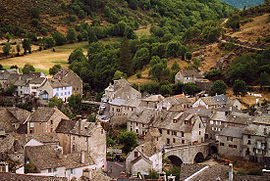Le Pont-de-Montvert
| Le Pont-de-Montvert | ||
|---|---|---|

View of Le Pont-de-Montvert
|
||
|
||
| Coordinates: 44°21′51″N 3°44′40″E / 44.3642°N 3.7444°ECoordinates: 44°21′51″N 3°44′40″E / 44.3642°N 3.7444°E | ||
| Country | France | |
| Region | Occitanie | |
| Department | Lozère | |
| Arrondissement | Florac | |
| Canton | Saint-Étienne-du-Valdonnez | |
| Intercommunality | Cévennes au Mont Lozère | |
| Government | ||
| • Mayor (2008–2014) | Sophie Pantel | |
| Area1 | 90.25 km2 (34.85 sq mi) | |
| Population (1999)2 | 272 | |
| • Density | 3.0/km2 (7.8/sq mi) | |
| Time zone | CET (UTC+1) | |
| • Summer (DST) | CEST (UTC+2) | |
| INSEE/Postal code | 48116 /48220 | |
| Elevation | 665–1,699 m (2,182–5,574 ft) (avg. 875 m or 2,871 ft) |
|
|
1 French Land Register data, which excludes lakes, ponds, glaciers > 1 km² (0.386 sq mi or 247 acres) and river estuaries. 2Population without double counting: residents of multiple communes (e.g., students and military personnel) only counted once. |
||
1 French Land Register data, which excludes lakes, ponds, glaciers > 1 km² (0.386 sq mi or 247 acres) and river estuaries.
Le Pont-de-Montvert is a former commune in the Lozère département in southern France. On 1 January 2016, it was merged into the new commune of Pont-de-Montvert-Sud-Mont-Lozère.
It is located in the heart of the Parc National des Cévennes. The inhabitants of Le Pont-de-Montvert are called Pontoises or Montvertipontains.
Late Neolithic standing stones called the menhirs of the Cham des Bondons, the largest concentration of menhirs in the south of France, bear mute witness to the long prehistory of human occupation here. The village was a fief of the Knights Hospitaller. Guillaume de Grimoard, future pope under the name of Urban V, was born in the Château de Grizac here in 1309. The picturesquely sited structure, no larger than a farm, reveals its defensive nature by its narrow windows, perched high in its granite walls, and its four-square tower, now topless. Charles V exempted the seigneurie de Grizac from all taxes, a privilege its lords maintained until the Revolution.
In the 17th century it remained a local centre of ardent French Protestants ("Huguenots") in a traditionally highly independent region; an incident in the village, the assassination on 24 July 1702 of the repressive François Langlade abbé de Chayla, sparked the rebellion of the Camisards. Langlade had chosen to use his house as prison, he had arrested and tortured a group of seven Protestants accused of attempting to flee France. A band of Camisards, led by Abraham Mazet peacefully asked for the release of the prisoners, but when this was refused they slaughtered Langlade and two priests.
...
Wikipedia



